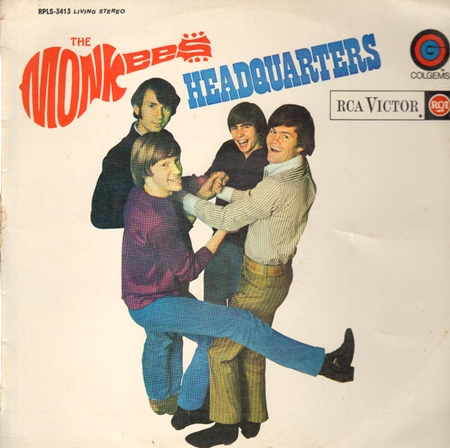
The Monkees: Headquarters (Colgems/RCA)
This album meant a lot to The Monkees because for once they had gained artistic control and could enter the studio as a band, not hired puppets. To this day “Headquarters” is the one moment in their lifespan as The Monkees that only brings back happy memories. They had fought the system and won. They were not exactly on the same planet musically, but during these calm days in March 1967 they had the RCA-studios at Sunset Boulevard to themselves and interacted with the one common goal: To show the world that, yes, The Monkees is actually a band and they can play.
Unfortunately the musketeer-phase didn’t last long, they quickly switched to “White Album”-mode for the subsequent albums (appearing as guests on each other’s songs) before it unraveled in earnest and they basically just recorded their share of the albums separately.
“Headquarters” is no masterpiece, but it is an unpretentious pop album with nice touches of country, light psychedelia and plain fun. Every tune wears a smile on its face, and there’s even some studio-banter and short jokes included. Unfortunately the suprisingly fresh and jolly record was completely overshadowed by “Sgt. Pepper” released only a few days later. The Monkees proved they could play, but they sure didn’t play in the same league as “the four kings of EMI”.
Well, who did? The Monkees had hoped that “Headquarters” would bring them some recognition, and even if it did, the achievement was soon dwarfed by the Jimi Hendrix-incident in July 1967. The Monkees brought Jimi Hendrix with them as opening act on their US tour, an unlikely pairing that ended after just eight nights when Hendrix dropped out of the tour, annoyed by the screams for Davy when he tore into “Purple Haze”. After he left the tour he offered the following explanation to New Musical Express: “Some parents who brought their young kids complained that our act was vulgar. We decided it was just the wrong audience. I think they’re replacing me with Mickey Mouse.”
A bizarre incident it was, and it did no good to the Monkees’ quest for recognition. As it was, “Headquarters” sold to the young fans who didn’t care if they played on their own records or not anyway, but was not on the list of cool albums to own in the summer of love.
A pity. Years on the album’s status has grown. It is a playful, unpretentious and very entertaining record. The atmosphere is warm and friendly, the musical statements simple, yet strong enough to earn your respect.
As usual on most Monkees-albums, Michael Nesmith delivers the more interesting and artful ’toons’, but it was Micky Dolenz who in a rare moment of inspiration wrote the album’s most famous and commercial song, “Randy Scouse Git”. The song was so strong that its was decided to release it as a single in England, but as the English, unlike Dolenz, knew what a Randy Scouse Git was, they renamed it “Alternate Title”. And under this name it became a smash hit all over Europe that summer.
The Nesmith-stuff is all stellar, my personal favourite being the slightly psychedelic “You Told Me” (with its musical references to The Beatles’ “Taxman”) and “Sunny Girlfriend”. Davy Jones never was much of a vocalist, but he sure shines on “Forget That Girl” and on the Cynthia Weil/Barry Mann-chestnut “Shades Of Gray” where he shares the spotlight with Peter Tork in one of the latter’s very few vocal contributions to The Monkees-catalogue.
I was about to end this piece with “if you’re gonna buy one Monkees-album…” etc, but as I was writing it I remembered that I actually have all their albums both on vinyl and CD, and I don’t regret buying a single one of them. Except for the last official Monkees-album “Changes”, made in 1970 when the band was reduced to a duo (Mick and Davy), they all have something to offer and have stood the test of time. And of course you buy “Changes” too, be a completist, it’s fun!
I talked to Neil Young over a dinner one late evening after a concert in 1976. Normally I never ask famous people for their autograph, but this was Neil Young. I had a pen, no paper but a plastic bag with a record I had bought in a second hand shop a few hours earlier. Why not? I thought and handed him the pen and the album. “Would you mind?” Neil lit up like a Christmas tree. “That’s a classic!” he grinned and wrote “Rock’n’roll for ever! Neil Young” on the “Pisces, Aquarius, Capricorn & Jones Ltd”-sleeve, turning it into one of the rarest Monkees-records ever.
If Neil Young likes them, you can. “Headquarters” is as good a start as any.
Released: May 1967 (June 1967 in Europe)
Side 1
1.”You Told Me” (2:22) (Michael Nesmith)
2.”I’ll Spend My Life With You” (2:23) (Tommy Boyce, Bobby Hart)
3.”Forget That Girl” (2:21) (Douglas Farthing-Hatlelid)
4.”Band 6″ (0:38) (Micky Dolenz, Davy Jones, Nesmith, Peter Tork)
5.”You Just May Be the One” (2:00) (Nesmith)
6.”Shades of Gray” (3:20) (Barry Mann/Cynthia Weil)
7.”I Can’t Get Her Off Of My Mind” (2:23) (Boyce, Hart)
Side 2
1.”For Pete’s Sake” (2:10) (Tork/Joey Richards)
2.”Mr. Webster” (2:02) (Boyce, Hart)
3.”Sunny Girlfriend” (2:31) (Nesmith)
4.”Zilch” (1:05) (Dolenz, Jones, Nesmith, Tork)
5.”No Time” (2:09) (Hank Cicalo)
6.”Early Morning Blues and Greens” (2:35) (Diane Hildebrand/Jack Keller)
7.”Randy Scouse Git” (aka “Alternate Title”) (2:35) (Dolenz)
(Produced by Chip Douglas)
Personnel:
Michael Nesmith: vocals, pedal steel guitar, 6-string guitar, organ
Davy Jones: vocals, tambourine, jawbone, maracas, etc.
Micky Dolenz: vocals, drums, guitar
Peter Tork: vocals, keyboards, 12-string guitar, bass guitar, 5-string banjo
Chip Douglas: bass guitar
John London: bass guitar on “The Girl I Knew Somewhere” and “All of Your Toys”
Vince DeRosa: French Horn on “Shades of Gray”
Fred Seykora: cello on “Shades of Gray”
Jerry Yester: additional guitar on “No Time”
Keith Allison: additional guitar on “No Time”
First published in Pattaya Mail on July 18, 2013
 |
 |
 |





